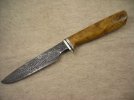- Joined
- Feb 5, 2010
- Messages
- 3,911
Today, while looking through my supply drawer, I noticed a lot of pieces of antler that were not stabilized (i.e. not really usable). I then glanced at my can of Minwax Wood Hardener.
I started dipping the antler pieces into the stuff... seems to be doing a good job of filling the voids in the spongy center part of the antler. Sometimes it darkens that sections, sometimes not. In either case, though, it makes it a lot more solid.
When you drop a piece of antler in, bubbles come flowing out of any exposed ends. Move the container around until the bubbles stop, then remove the piece. Let it dry, then do it again... and again... until dipping it generates no bubbles.
I figure the one can gave me a couple dozen usable pieces.
And there's still some left over in the dipping cup.
- Greg
I started dipping the antler pieces into the stuff... seems to be doing a good job of filling the voids in the spongy center part of the antler. Sometimes it darkens that sections, sometimes not. In either case, though, it makes it a lot more solid.
When you drop a piece of antler in, bubbles come flowing out of any exposed ends. Move the container around until the bubbles stop, then remove the piece. Let it dry, then do it again... and again... until dipping it generates no bubbles.
I figure the one can gave me a couple dozen usable pieces.
And there's still some left over in the dipping cup.
- Greg

